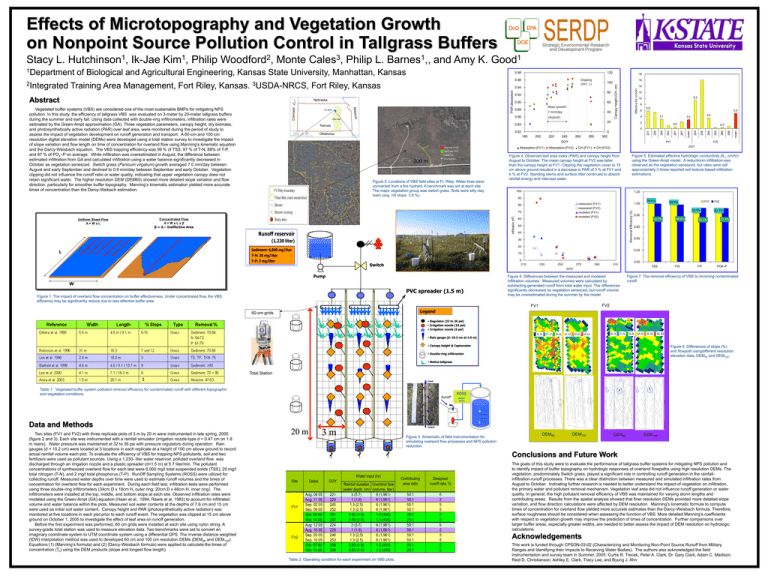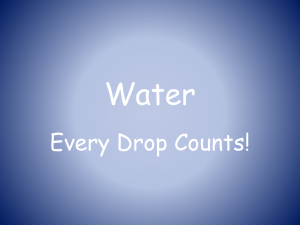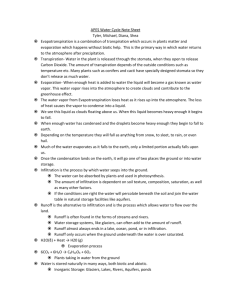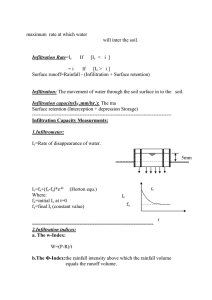Effects of Microtopography and Vegetation Growth
advertisement

Effects of Microtopography and Vegetation Growth on Nonpoint Source Pollution Control in Tallgrass Buffers Monte 3 Cales , Philip L. 1 Barnes ,, and Amy K. 1 Good of Biological and Agricultural Engineering, Kansas State University, Manhattan, Kansas 0.98 120 Clipping (Oct. 1) 0.96 Training Area Management, Fort Riley, Kansas. 3USDA-NRCS, Fort Riley, Kansas 0.94 PAR absorption Abstract Vegetated buffer systems (VBS) are considered one of the most sustainable BMPs for mitigating NPS pollution. In this study, the efficiency of tallgrass VBS was evaluated on 3-meter by 20-meter tallgrass buffers during the summer and early fall. Using data collected with double-ring infiltrometers, infiltration rates were estimated by the Green-Ampt approximation (GA). Three vegetation parameters, canopy height, dry biomass, and photosynthetically active radiation (PAR) over leaf area, were monitored during the period of study to assess the impact of vegetation development on runoff generation and transport. A 60-cm and 100-cm resolution digital elevation model (DEMs) were developed using a total station survey to investigate the impact of slope variation and flow length on time of concentration for overland flow using Manning’s kinematic equation and the Darcy-Weisbach equation. The VBS trapping efficiency was 99 % of TSS, 97 % of T-N, 88% of T-P, and 87 % of PO4--P on average. While infiltration was overestimated in August, the difference between estimated infiltration from GA and calculated infiltration using a water balance significantly decreased in October as vegetation senesced. Switch grass (Panicum virgatum) growth averaged 7.0 mm/day between August and early September and declined to 0.9 mm/day between September and early October. Vegetation clipping did not influence the runoff ratio or water quality, indicating that upper vegetation canopy does not retain significant water. The higher resolution DEM (DEM60) showed more detailed slope variation and flow direction, particularly for smoother buffer topography. Manning’s kinematic estimation yielded more accurate times of concentration than the Darcy-Weibach estimation. 60 Mean growth: 0.88 7 mm/day 40 (August) 14 12 9.3 10 8 6 5.8 5.0 3.1 4 20 0.84 3.5 3.0 2 0.6 0.3 DOY Absorption (FV1) 300 m Absorption (FV2) CH (FV1) DOY Figure 5. Estimated effective hydrologic conductivity (Ks, cm/hr) using the Green-Ampt model. A reductionin infiltration was observed as the vegetation senesced, but rates were still approxiamtely 3 times reported soil texture-based infiltration estimations. 1.20 90 80 measured (FV1) 70 measured (FV2) modeled (FV1) 1.00 modeled (FV2) 60 50 40 30 99.6% FV1 96.9% 83.5% FV2 82.7% 0.80 99.7% 98.0% 92.2% 91.7% 0.60 0.40 20 Sediment: 6,000 mg/liter T-N: 20 mg/liter T-P: 2 mg/liter 0.20 10 0 210 Switch 230 250 270 290 310 DOY Pump Figure 6. Differences between the measured and modeled infiltration volumes. Measured volumes were calculated by subtracting generated runoff from total water input. The differences significantly decreased as vegetation senesced, but runoff volume may be overestimated during the summer by the model. W PVC spreader (1.5 m) Figure 1. The impact of overland flow concentration on buffer effectiveness. Under concentrated flow, the VBS efficiency may be significantly reduce due to less effective buffer area. 0.00 TSS T-N T-P PO4--P Figure 7. The removal efficiency of VBS to incoming contaminated runoff. FV2 FV1 Legend 60-cm grids • Regulator (32 to 36 psi) • Irrigation nozzle (10 psi) • Irrigation nozzle (6 psi) • Rain gauge (d: 10.2 cm at 1.0 m) • Canopy height & Ceptometer Figure 8. Differences of slope (%) and flowpath usingdifferent resolution elevation data, DEM60 and DEM100. • Double-ring infiltromter • Native tallgrass Total Station 3 Input Table 1. Vegetated buffer system pollutant removal efficiency for contaminated runoff with different topographic and vegetation conditions. Runoff ROSS (slope: 20%) 4 1 Data and Methods Two sites (FV1 and FV2) with three replicate plots of 3 m by 20 m were instrumented in late spring, 2005 (figure 2 and 3). Each site was instrumented with a rainfall simulator (irrigation nozzle-type d = 0.47 cm on 1.8 m risers). Water pressure was maintained at 32 to 36 psi with pressure regulators during operation. Rain gauges (d = 10.2 cm) were located at 3 locations in each replicate at a height of 100 cm above ground to record actual rainfall volume each plot. To evaluate the efficiency of VBS for trapping NPS pollutants, soil and two fertilizers were used as pollutant sources. Using a 1,230- liter water reservoir, polluted overland flow was discharged through an irrigation nozzle and a plastic spreader (d=1.5 m) at 5.7 liter/min. The pollutant concentrations of synthesized overland flow for each test were 6,000 mg/l total suspended solids (TSS), 20 mg/l total nitrogen (T-N), and 2 mg/l total phosphorus (T-P). RunOff Sampling Systems (ROSS) were utilized for collecting runoff. Measured water depths over time were used to estimate runoff volumes and the times of concentration for overland flow for each experiment. During each field test, infiltration tests were performed using three double-ring infiltrometers (34cm D x 18cm H, outer ring; 20cm D x 46cm H, inner ring). The infiltrometers were installed at the top, middle, and bottom slope at each site. Observed infiltration rates were modeled using the Green-Ampt (GA) equation (Haan et al., 1994; Rawls et al, 1983) to account for infiltrated volume and water balance within the plots. Measured soil water contents at the depths of 7.6 cm and 15 cm were used as initial soil water content. Canopy height and PAR (photosynthetically active radiation) was monitored at five locations in each plot prior to each runoff event. The vegetation was clipped at 15 cm above ground on October 1, 2005 to investigate the effect of leaf area on runoff generation. Before the first experiment was performed, 60 cm grids were installed at each site using nylon string. A survey-grade total station was used to measure elevation data. Two benchmarks were set to convert an imaginary coordinate system to UTM coordinate system using a differential GPS. The inverse distance weighted (IDW) interpolation method was used to developed 60 cm and 100 cm resolution DEMs (DEM60 and DEM100). Equations (1) (Manning’s formula) and (2) (Darcy-Weisbach formula) were applied to calculate the times of concentration (Tc) using the DEM products (slope and longest flow length). Output 20 m 3m Figure 3. Schematic of field instrumentation for simulating overland flow processes and NPS pollution reduction. DEM60 DEM100 DEM60 DEM100 Conclusions and Future Work Water input (hr) Site FV1 FV2 mean 288 280 253 246 FV2 CH (FV2) 100 3 (1,230 liter) FV1 Figure 4. Observed leaf area index (PAR) and canopy height from August to October. The mean canopy height at FV2 was taller than the canopy height at FV1. Clipping the vegetation cover to 15 cm above ground resulted in a decrease in PAR of 3 % at FV1 and 6 % at FV2. Standing stems and surface litter continued to absorb rainfall energy and intercept water. Infiltration (m ) Figure 2. Locations of VBS field sites at Ft. Riley. Water lines were connected from a fire hydrant. A benchmark was set at each site. The major vegetation group was switch grass. Soils were silty clay loam (avg. hill slope: 3.9 %). 228 280 224 260 mean 240 287 220 281 200 252 180 0 300 245 0.82 229 0 Runoff reservoir L 0.90 0.86 Concentrated Flow A=WxLxβ β = A – Ineffective Area Uniform Sheet Flow A=WxL 80 0.92 16 221 2Integrated 100 18 Effective Ks (cm/hr) Philip 2 Woodford , Removal Efficiency (%) 1Department Ik-Jae 1 Kim , Canopy height (CH, cm) Stacy L. 1 Hutchinson , Dates DOY Aug. 09 05 Aug. 17 05 Sep. 02 05 Sep. 09 05 Oct. 08 05 Oct. 14 05 Aug. 12 05 Aug. 16 05 Sep. 03 05 Sep. 10 05 Oct. 07 05 Oct. 15 05 221 229 245 252 281 287 224 228 246 253 280 288 Rainfall duration Overland flow (water depth, cm) (volume, liter) 3 (5.7) 6 (1,961) 1 (1.9) 6 (1,961) 1.3 (2.5) 6 (1,961) 1.3 (2.5) 6 (1,961) 0.83 (1.9) 1.3 (435) 0.83 (1.9) 1.3 (435) 3 (5.7) 6 (1,961) 1 (1.9) 6 (1,961) 1.3 (2.5) 6 (1,961) 1.3 (2.5) 6 (1,961) 0.83 (1.9) 1.3 (435) 0.83 (1.9) 1.3 (435) Table 2. Operating condition for each experiment on VBS plots. Contributing area ratio Designed runoff rate, % 50:1 50:1 50:1 50:1 25:1 25:1 50:1 50:1 50:1 50:1 25:1 25:1 6 2 5 5 2 2 6 2 5 5 2 2 The goals of this study were to evaluate the performance of tallgrass buffer systems for mitigating NPS pollution and to identify impact of buffer topography on hydrologic responses of overland flowpaths using high resolution DEMs. The vegetation, predominately Switch grass, played a significant role in controlling runoff generation in the rainfallinfiltration-runoff processes. There was a clear distinction between measured and simulated infiltration rates from August to October. Indicating further research is needed to better understand the impact of vegetation on infiltration, the primary water and pollutant removal mechanism. Vegetation leaf area did not influence runoff generation or water quality. In general, the high pollutant removal efficiency of VBS was maintained for varying storm lengths and contributing areas. Results from the spatial analysis showed that finer resolution DEMs provided more detailed slope variation, and flow direction calculations were affected by DEM resolution. Manning’s kinematic formula to compute times of concentration for overland flow yielded more accurate estimates than the Darcy-Weisbach formula. Therefore, surface roughness should be considered when assessing the function of VBS. More detailed Manning’s coefficients with respect to vegetation growth may improve the prediction of times of concentration. Further comparisons over larger buffer areas, especially greater widths, are needed to better assess the impact of DEM resolution on hydrologic calculations. Acknowledgements This work is funded through CPSON-03-02 (Characterizing and Monitoring Non-Point Source Runoff from Military Ranges and Identifying their Impacts to Receiving Water Bodies). The authors also acknowledged the field instrumentation and survey team in Summer, 2005: Curtis R. Trecek, Peter A. Clark, Dr. Gary Clark, Adam C. Madison, Reid D. Christianson, Ashley E. Clark, Tracy Lee, and Byung J. Ahn







